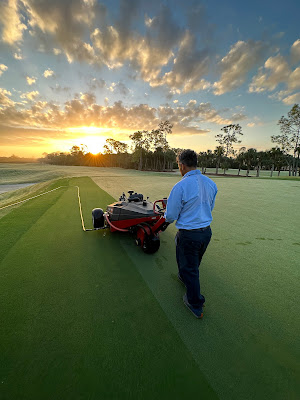A common question in the golf industry is, “Why do you aerify greens when they are in great condition?” The quick answer is that weather plays a large role in recovery. Therefore, performing aeration when the weather favors turf growth leads to quicker recovery. Aeration is also stressful on turf so performing the task when the turf is in "great" condition is also vital.
 |
| Practice Green 7/4/23 - 7 Days after Aerification |
We are fortunate in Southwest Florida this coincides with the time of year the majority of the membership has left for the summer. At Olde Florida we perform various types of aeration throughout the summer; however, we are most aggressive in the early to mid-summer. One reason is the days are the longest. The summer solstice (longest day of the year) was June 21.
We also want to perform aggressive aerification earlier in the summer to avoid cloudy, rainy days. Weather is obviously unpredictable, but in general as summer in Southwest Florida progresses, we see an increase in cloudy weather. Clouds and rain reduce sunlight, and sunlight is essential to warm season turfgrass recovery. Historically we also have a greater likelihood of severe weather from tropical systems or hurricanes as the summer progresses. The negative impacts from severe storms could delay or cancel scheduled procedures, or at a minimum slow the turf recovery.
 |
| Topdressing - Practice Green 6/26/23 |
 |
| Core Aeration - Practice Green 6/26/23 |
Another question that is sometimes asked in the golf industry is simply, “WHY do you aerate?” At its most basic, aeration helps keep soil "healthy" and healthy soil plays a significant role in healthy turfgrass.
Agronomy textbooks teach that “healthy soil” consists of:
- 45% solids
- 25% air
- 25% water
- 5% organic material
 |
| "Healthy Soil" - Practice Green |
In more detail, when done in conjunction with sand topdressing core aeration:
- Reduces compaction
- Dilutes organic matter
- Improves infiltration
- Increases oxygen exchange
- Reduces dry spots
It’s also important to vary the depths of aerification practices to prevent the development of compacted layers in the soil profile. At Olde Florida we utilize two processes to achieve this, the Drill and Fill and the DryJect aerification methods. Both have advantages, and most years we will contract one of each.
With the Drill and Fill soil is brought to the surface and the holes are filled with kiln dried sand. The diameter and length of the bits are customized to each property At Olde Florida we utilize a 1" bit, set to a depth of 10”. The top 7-8” of our greens profile is the zone that we have organic buildup from 31 years of growth.
 |
| Drill and Fill - Practice Green 5/30/23 |
Drill and Fill (video) - Practice Green 5/30/23
The Dryject has a quicker recovery time than the Drill and Fill, but the depth can be variable depending on soil conditions. Also, no organic material is removed with the DryJect. At the end of summer, after numerous cultivations we can achieve a sand depth of approximately 7” with the DryJect Maximus process.
 |
| DryJect - Practice Green 10/4/22 |
DryJect (video) - Practice Green 10/4/22
Our goal has been, and will always remain to perform the more aggressive cultural practices during one of the five, week-long closures to reduce the impact to our summer players.
When conditions do not favor quick recovery we also utilize several less aggressive aeration processes. These include; "Ninja tine," "needle tine," and water injection aeration. The Ninja tine is fairly new to the industry, but it's gaining popularity due its ability to pull a consistent small core; consequently, removing organic matter with minimal disruption. The needle tine and water injection aeration methods do not "pull a core" so no organic material is removed. These practices have no impact on the surface and most players never know the procedure has been performed.
 |
| The Hydroject - 8 Green 2/23/23 |
Aerifying greens, even when they appear healthy, is essential for maintaining long-term turf health and playability. This process improves soil aeration, relieves compaction, and promotes deeper root growth, ensuring the grass remains strong and resilient. While it may temporarily disrupt the surface, the long-term benefits, such as better drainage and disease prevention, make it a necessary practice for maintaining high-quality greens.
ReplyDelete____________
Grow a lush lawn with sunday grass seed!